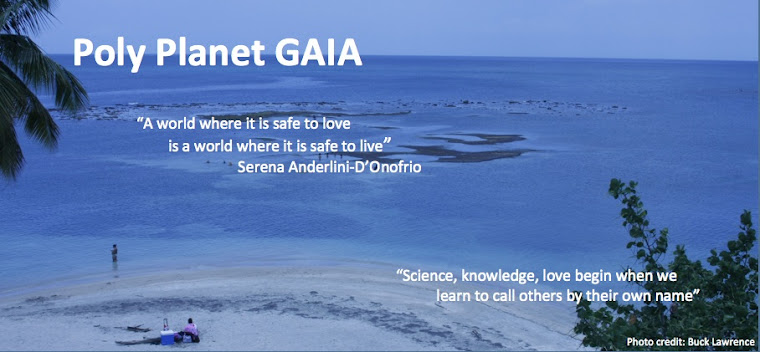Entry: The
Gaia Hypothesis
Serena Anderlini-D’Onofrio,
PhD
1. Introduction: The
Epistemic Axiom
The Gaia Hypothesis is a term currently used in scientific
discourse to denote a major axiom in post-modern epistemologies. The biota, or sum of atmosphere and
biosphere, marks the difference between third planet Earth and its neighbors
Mars and Venus. This web of
interconnected ecosystem constitutes a sovereign entity that is over four
billion years old and has the power to perpetuate itself at the expense of any
species that might constitute a threat to its balance and homeostasis. To the woeful surprise of many humans, this
sovereign power also applies to our species.
The Gaia Hypothesis is a scientific theory of the
pardigmatic order: it shifts the foundation of knowledge that characterizes an
age. In this, it can be compared to the
cosmological theory that came to be known as the Copernican revolution: a
theory that marked the modern era with the interpretation of the Earth as a revolving
sphere also in motion around a center outside of itself, rather than a immobile
sphere around which everything else revolves.
Just like Copernicus’s paradigm accentuates dynamism over stability, so the
Gaia Hypothesis accentuates interconnectedness over individuality. Just like modernity is marked by a focus on
humankind as a species with a special potential and destiny, so post-modernity
is marked by a focus on global ecology and planetary consciousness: sovereign
entities with whom human consciousness is free to align or not, at its own
risk.
As a scientific theory, the Gaia Hypothesis is associated
with two main scientists of the second half of the 20th Century: the
independent scientist, ecologist, and futurologist James Lovelock, based in
Devon, England; and the late geoscientist, biologist, and university professor
at U Mass, Amherst, Lynn Margulis.
Lovelock is responsible for the macrocosmic aspects of the theory: the observation that planetary homeostasis
has been maintained overtime at the expense of species or varieties within a species
that constituted a threat to the overarching balance of life as a whole; and
the diagnosis of Earth as an ailing patient in need of immediate medical
attention, due to persistent human abuse.
In Lovelock’s perspective, this attention could come in the form of
replacing fossil-fuel energy with nuclear energy, which would be exclusively
devoted to civil use.
 Margulis focuses on the microcosmic aspects of the theory
and extrapolates significant global conclusions. Margulis articulates a Gaian perspective on
evolution that involves a critique of Darwinian emphasis on selection and
competition. The main force that sustains
life across time and space is symbiosis and collaboration. Further, Margulis interprets symbiosis as a
form of sexual expression that helps to sustain the life of a species that
engages in it, much beyond the reproductive intent of any of its individuals. From this perspective, life, consciousness, sex,
love started with bacteria about four billion years ago. These prokaryotic unicellular organisms are
our first ancestors and our symbionts: namely the smaller organisms that
aggregate to form larger and more complex ones like ours. So, based on this axiom, our ancestors
bacteria are symbiotic and accustomed to sharing resources of love. They have recreational sex with their neighbors
to stay in good health. Since they’ve
been around for so long, one might infer that we would probably do well to
learn something from them.
Margulis focuses on the microcosmic aspects of the theory
and extrapolates significant global conclusions. Margulis articulates a Gaian perspective on
evolution that involves a critique of Darwinian emphasis on selection and
competition. The main force that sustains
life across time and space is symbiosis and collaboration. Further, Margulis interprets symbiosis as a
form of sexual expression that helps to sustain the life of a species that
engages in it, much beyond the reproductive intent of any of its individuals. From this perspective, life, consciousness, sex,
love started with bacteria about four billion years ago. These prokaryotic unicellular organisms are
our first ancestors and our symbionts: namely the smaller organisms that
aggregate to form larger and more complex ones like ours. So, based on this axiom, our ancestors
bacteria are symbiotic and accustomed to sharing resources of love. They have recreational sex with their neighbors
to stay in good health. Since they’ve
been around for so long, one might infer that we would probably do well to
learn something from them.
To be continuded . . . . come back next week, same time.
Sending
much love and all good wishes to all of you and your loved ones.
Thanks you for listening and opening up. Stay tuned for more coming.
With all good wishes for a happy end of winter, spring, and summer.
Thank you!
Namaste,
SerenaGaia
Serena Anderlini-D'Onofrio, PhD
Author of Gaia, Eros, and many other books about love Professor of Humanities, University of Puerto Rico, Mayaguez
Poly Planet GAIA Blog: http://polyplanet.blogspot.
Become a Fan: www.facebook.com/GaiaBlessings
Go to Author's Page/Lists all Books:
http://www.amazon.com/-/e/
YouTube Uploaded Videos: http://www.youtube.com/
Be Appraised of Ecosex Community Project PostaHouse










No comments:
Post a Comment